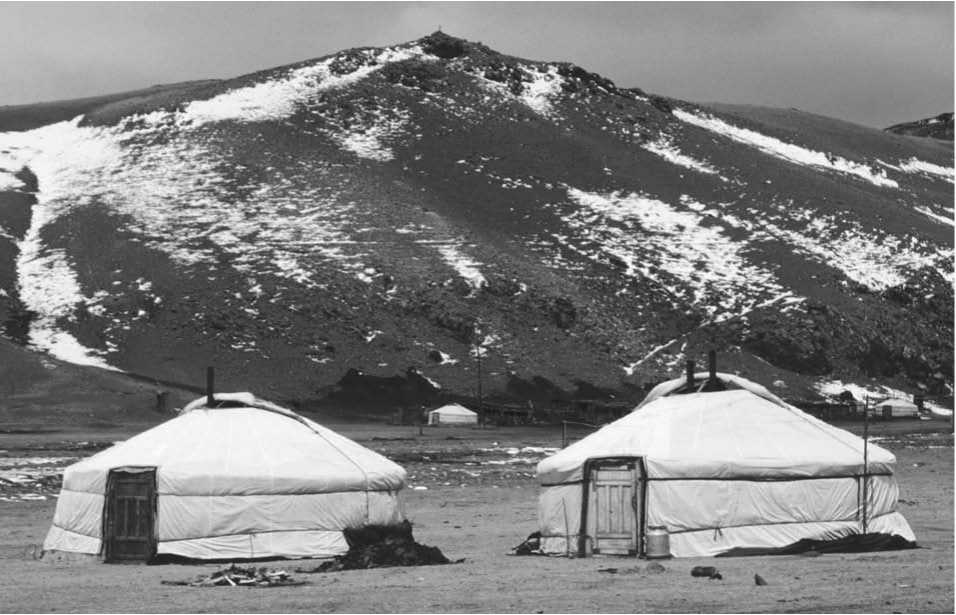Mongolian men and women wore similar clothes, starting with a robe called a de’el. The robe might be lined with fur for warmth, and was closed with a belt. The outer part of the robe was usually covered in silk. Poorer

People lined their clothing with wool or cotton. Underneath the de’el Mongols wore pants and some kind of an undershirt. During cold weather, they wore overcoats made of felt or fur. On their feet they wore thick stockings and boots made of leather, or in very cold weather, felt.
No Barbecues
If the Mongols lacked fuel for a fire, they ate their meat raw, chopping it up and mixing it with garlic. The Mongol taste for raw meat led European chefs to name a dish for them, steak tartare, which uses raw beef that is finely chopped and mixed with spices.
For many meals, the Mongols roasted meat over an open flame, and they continued that tradition even as they mixed with Asia's sedentary cultures. But the Mongols did not introduce the so-called Mongolian barbecue, which is found in some U. S. restaurants today. In these restaurants, diners choose from a variety of meats and vegetables, which are then cooked in oil in a large pan. This style of cooking is actually a Chinese invention and has nothing to do with the Mongols. In China, the meat and vegetables are cooked in a special pot with a cone in the center that holds burning charcoal, and a ring around the outside filled with boiling flavored broth.
The one main difference between male and female clothing was headgear. Wealthy women wore tall, fancy hats called boqtas, which were covered with feathers and pearls-hard-to-get trade goods.
Carpini wrote (in The Story of the Mongols Whom We Call the Tartars) that only married women wore boqtas, making it difficult to tell an unmarried woman from a man, since she would not wear a boqta and the rest of her clothing was just like a man’s. Men usually wore fur hats with flaps that covered the ears.
The basic Mongol food was dairy products and meat, either from their herd or game animals such as rabbits and fowl killed during their hunts. To a lesser degree, men also fished. Some meat was dried in the sun, which preserved it and made it easy to eat while on horseback. Bones, with some meat still attached, were boiled in a broth called shulen. Later this term was used to describe a stew of broth and meat thickened with grains or beans. Plant foods included seeds, berries, fruit, and mushrooms.
Before the Mongol conquests, a typical meal did not vary much from boiled meat and dairy products, but the growth of the empire led to the introduction of new foods, many from the Turkic peoples of Central Asia. One Turko-Mongolian dish was a rich pastry similar to baklava, which features layers of nuts, spices, and sugar. The word baklava seems to come from the Mongol word bakla, which means “pile up in layers.” Mongols may have introduced this sweet treat to the Middle East and other lands they conquered. The Mongols also developed a taste for dishes from China and Persia.
Blood Brothers
The young Chinggis Khan had a "blood brother." When he was 11, Temujin and a friend exchanged gifts, marking their commitment to one another. Nomadic blood brothers also mixed a few drops of their blood in a glass and drank from it, although there is no record Temujin did this. These choices were made by the young men themselves, but for the Mongols, choosing a blood brother was not merely child's play. Taking a blood brother created an anda, a relationship that united two men as political and military allies through their adulthood.
During the time of the khanates, the common people provided food for the royal family and other leaders. The commoners ate whatever crops they grew that did not go to the Mongol elite or foods they obtained from trading animals or furs. As for slaves, William of Rubruck, in his book The Journey of William of Rubruck to the Eastern Parts of the World, 1253-1255, as Narrated by Himself, wrote that they “fill their bellies with dirty water, and with this they are content.” At times the slaves also caught rats or mice for their meals.




 World History
World History









